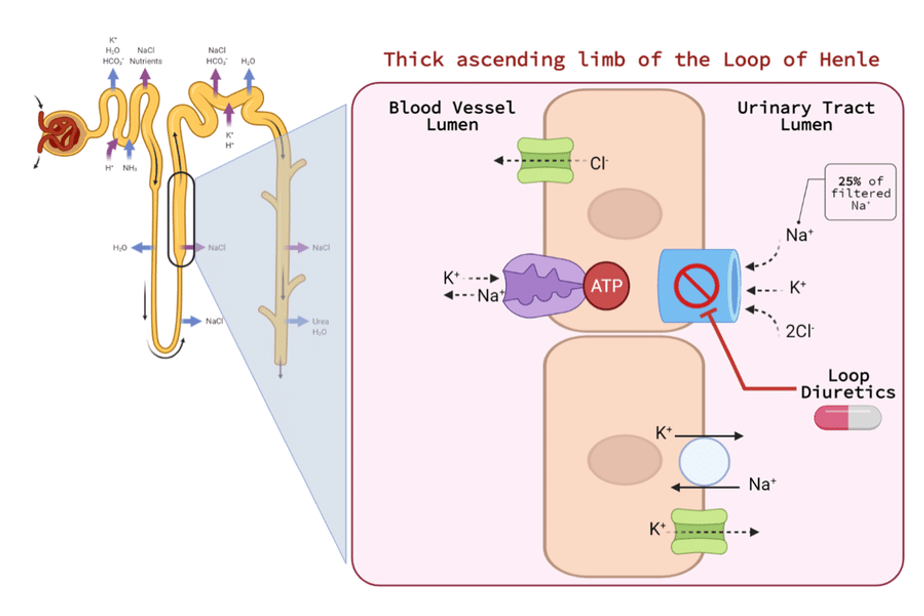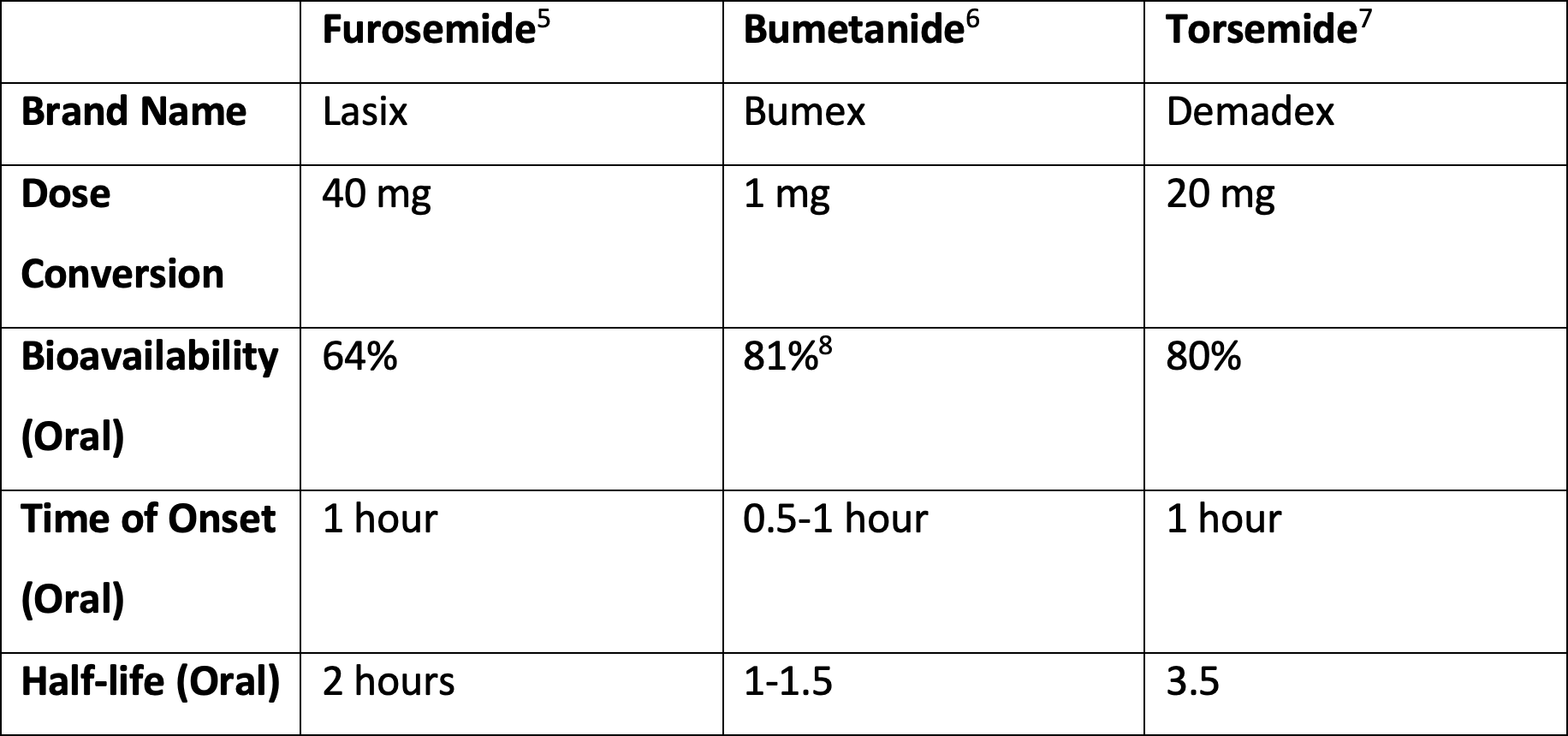Article
A Brief Overview of Loop Diuretics Used in Heart Failure
Author(s):
The combination of loop diuretics with other drugs that act at different pharmacologic targets has been shown to improve diuretic response in patients with heart failure.
Although not one of the four pillars for mortality benefit in heart failure with reduced ejection fraction (HFrEF),1 loop diuretics are a staple in the pharmacologic management of heart failure. These diuretics are used at the lowest effective dose to achieve euvolemia and reduce edema in patients with heart failure.2
Mechanism of Action
Loop diuretics inhibit the sodium potassium chloride (Na-K-Cl) co-transporter present in the luminal membrane thick ascending Loop of Henle within the nephron, hence the name “loop” diuretics. These medications bind to the chloride binding site on the luminal side of the co-transporter, inhibiting its action.3 This inhibits sodium reabsorption from the lumen in the nephron, and therefore causes a natriuretic effect.3

Image4
Adverse Effects (AEs)
Because loop diuretics act on a transporter that affects electrolyte control within the kidneys, some of the AEs associated with loop diuretics are associated with electrolyte imbalances. These include hypokalemic alkalosis, as well as hypomagnesemia.3 Other AEs loop diuretics can cause include extracellular fluid volume depletion, hypersensitivity, and ototoxicity.3
Comparisons
Furosemide is the most commonly used loop diuretic in heart failure, but bumetanide and torsemide are good options for patients who develop resistance to furosemide.2 Torsemide has the unique ability to act a as a RAAS antagonist, which has extra benefits in CHF patients.4 Bioavailability is a major difference in these agents, as well. Below is a table comparing properties of each loop diuretic.

Threshold Doses and Ceiling Effects3
Loop diuretics exhibit a unique dose to effect relationship. Loop diuretics have a “threshold effect,” which is the minimum effective dose for the diuretic. To get the appropriate diuretic response, the patient must be at or above the threshold.
Doses below this will not result in therapeutic diuresis. Increasing the dose further increases diuresis until the ceiling effect occurs. At a certain point while escalating the dose, the increasing response will level out, where higher doses do not result in a greater diuretic effect.
This is when frequency can be adjusted to achieve optimal output. There is no set dose for the threshold or the ceiling effects, as each patient has a unique dose response. Monitoring and maintaining doses between the threshold and the ceiling for each patient is important to ensure a therapeutic clinical response.
Diuretic Resistance and the Augmenting of Diuresis
Diuretic resistance occurs when loop diuretics, even at the ceiling effect doses, fail to cause the appropriate diuresis response.9 Resistance can occur by multiple mechanisms, but can sometimes be augmented with the concurrent use of other diuretics.9
The combination of loop diuretics with other drugs that act at different pharmacologic targets has been shown to improve diuretic response. Thiazide diuretics, which work in the distal convoluted tubule, have also been shown to increase diuresis when given with loop diuretics.10
Sodium-glucose cotransporter-2 inhibitors, which act in the proximal tubule of the nephron, have been shown to increase the natriuretic response when given concurrently with a loop diuretic, showing a synergistic effect.11,12 Most recently, the Acetazolamide in Acute Decompensated Heart Failure with Volume Overload (ADVOR) trial showed that in the inpatient setting, concurrent acetazolamide administration can improve diuretic response.13
References
- Straw, S., McGinlay, M., & Witte, K. K. (2021). Four pillars of heart failure: Contemporary pharmacological therapy for heart failure with reduced ejection fraction. In Open Heart (Vol. 8, Issue 1). BMJ Publishing Group. https://doi.org/10.1136/openhrt-2021-001585
- Casu, G., & Merella, P. (2015). Diuretic Therapy in Heart Failure – Current Approaches. European Cardiology Review, 10(1), 42. https://doi.org/10.15420/ecr.2015.10.01.42
- Ellison, D. H. (2019). Clinical pharmacology in diuretic use. Clinical Journal of the American Society of Nephrology, 14(8), 1248–1257. https://doi.org/10.2215/CJN.09630818
- Antonietta, C. M., Calvi, E., Faggiano, A., Maffeis, C., Bosisio, M., de Stefano, M., Carugo, S., & Faggiano, P. (2022). Impact of Loop Diuretic on Outcomes in Patients with Heart Failure and Reduced Ejection Fraction. Current Heart Failure Reports, 19(1), 15–25. https://doi.org/10.1007/s11897-021-00538-7
- Furosemide [package insert] Bridgewater, NJ: Sanofi-Aventis U.S. LLC; 2011
- Bumetanide [package insert] Parsippany, NJ: Validus Pharmaceuticals LLC; 2008
- Torsemide [package insert] Somerset, NJ: Meda Pharmaceuticals Inc.
- Cook, J. A., Smith, D. E., Cornish, L. A., Tankanow, R. M., Nicklas, J. M., & Hyneck, M. L. (1988). Kinetics, dynamics, and bioavailability of bumetanide in healthy subjects and patients with congestive heart failure. Clinical Pharmacology and Therapeutics, 44(5), 487–500. https://doi.org/10.1038/clpt.1988.186
- Wilcox, C. S., Testani, J. M., & Pitt, B. (2020). Pathophysiology of Diuretic Resistance and Its Implications for the Management of Chronic Heart Failure. In Hypertension (Vol. 76, Issue 4, pp. 1045–1054). Lippincott Williams and Wilkins. https://doi.org/10.1161/HYPERTENSIONAHA.120.15205
- Kissling, K. T., & Pickworth, K. K. (2014). Comparison of the effects of combination diuretic therapy with oral hydrochlorothiazide or intravenous chlorothiazide in patients receiving intravenous furosemide therapy for the treatment of heart failure. Pharmacotherapy, 34(8), 882–887. https://doi.org/10.1002/phar.1456
- Wilcox, C. S., Shen, W., Boulton, D. W., Leslie, B. R., & Griffen, S. C. (2018). Interaction between the sodium-glucose-linked transporter 2 inhibitor dapagliflozin and the loop diuretic bumetanide in normal human subjects. Journal of the American Heart Association, 7(4). https://doi.org/10.1161/JAHA.117.007046
- Schulze, P. C., Bogoviku, J., Westphal, J., Aftanski, P., Haertel, F., Grund, S., von Haehling, S., Schumacher, U., Möbius-Winkler, S., & Busch, M. (2022). Effects of Early Empagliflozin Initiation on Diuresis and Kidney Function in Patients With Acute Decompensated Heart Failure (EMPAG-HF). Circulation, 146(4), 289–298. https://doi.org/10.1161/CIRCULATIONAHA.122.059038
- Mullens, W., Dauw, J., Martens, P., Verbrugge, F. H., Nijst, P., Meekers, E., Tartaglia, K., Chenot, F., Moubayed, S., Dierckx, R., Blouard, P., Troisfontaines, P., Derthoo, D., Smolders, W., Bruckers, L., Droogne, W., ter Maaten, J. M., Damman, K., Lassus, J., … Dupont, M. (2022). Acetazolamide in Acute Decompensated Heart Failure with Volume Overload. New England Journal of Medicine. https://doi.org/10.1056/NEJMoa2203094
Newsletter
Stay informed on drug updates, treatment guidelines, and pharmacy practice trends—subscribe to Pharmacy Times for weekly clinical insights.






